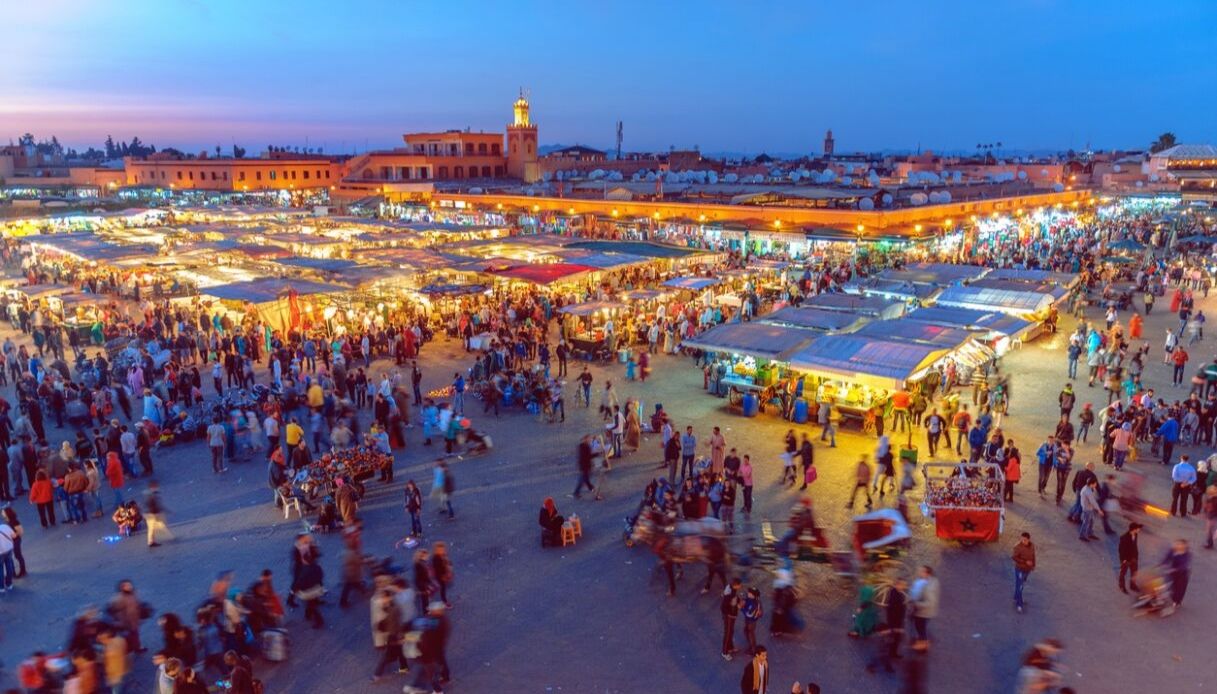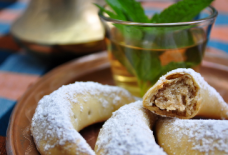From Souks to Sidewalks: Unveiling the Delights of Moroccan Street Food

By: Maryem Bouatlaoui / Arab America Contributing Writer
Step into the bustling world of Moroccan street food, where the aromas of spices and the sizzle of grills beckon you to indulge in a culinary escape like no other. Moroccan street food culture offers a sensory delight, showcasing the rich culinary heritage and cultural tapestry that defines the nation. From the vibrant squares of Marrakech to the bustling alleys of Chefchaouen, the streets of Morocco offer a generous array of flavors, textures, and colors that will awaken your senses. Get ready to immerse yourself in the vibrant tapestry of Moroccan street food, where authenticity, bold flavors, and an unforgettable adventure awaits.
Sfenj: Moroccan Doughnut
Sfenj is Morocco’s doughnut, a sizzling crispy delight. The deep-fried ring can be eaten sweet or savory, depending on one’s taste, but sfenj is usually topped with sugar, drizzled with honey, or spread with butter. Sfenj is eaten in the morning for breakfast and in the afternoon as a late snack. Sfenj is usually sold by the dozen, strung on a palm leaf.

According to Analducian folk stories, a baker accidentally invented sfenj by dropping some dough into a pan of sizzling, hot oil. Sfenj was popularized in the Anadalus region in the 13th century and then started to spread across the Maghreb. Some say that French beignets were inspired by sfenj.
Babouche: Snails and Stew
Yes, you heard right; one of Morocco’s most popular street foods is snails! Boiled in an aromatic stew, babouche is a Moroccan staple. The snail stew’s broth is seasoned with over fifteen different herbs and spices, including cumin, paprika, and thyme. While not as popular among tourists, locals enjoy a small bowl of babouche alongside a bowl of extra stew. Carts populate the corners of almost every bustling marketplace, serving locals and brave tourists alike.

ZaaZaa: Moroccan Smoothie
In Morocco, the vibrant world of street food extends beyond savory treats to include refreshing delights such as the Moroccan smoothie, Zaa Zaa. Zaa Zaa is a medley of avocados, apples, and bananas blended with dates, almonds, and walnuts, creating a nutritionally satisfying yet tasty drink. You can order a simple ZaaZaa smoothie or a lavishly decorated smoothie from almost any cafe or restaurant in Morocco!
Msemen: Moroccan Flatbread
Msemen is another Moroccan staple, enjoyed by every household at almost every time of the day. Similar to roti and naan, Msemen is a folded flatbread made with flour, semolina, and oil. It can be eaten on its own with butter, honey, cheese, or chocolate, or it can be used to top off traditional Moroccan dishes such as Rfissa. Msemen, in most Moroccan households, is served with Moroccan mint tea or coffee in the mornings and afternoons. Variations of Msemen include stuffed Msemen in which the flatbread is stuffed with onion, ground beef, and green peppers.

Msemen can be found all over the North African region in countries such as Morocco, Algeria, and Tunisia. It originates from the Amazigh community where the word msemem derives from the Amazigh verb “semneni,” which means “to stack.” This name is fitting as Msemen is usually made in large quantities and sold out quickly in local shops and carts.
Hummus Cumin
Hummus Cumin, not to be confused with the hummus dip, is a simple, yet delicious summer snack. It is just what it sounds like, a bowl of chickpeas topped with cumin. This dish is often sold in rolling carts on the beach and usually comes with hot sauce for those who prefer their chickpeas spicy.
Caliente
Caliente is a Moroccan dish made up of chickpea flour, eggs, and olive oil. It is sold in slices from a hot pan (hence the name, Caliente, from the Spanish word for “hot”) and topped with paprika powder. Caliente can either be eaten by itself or indulged with a piece of bread. It is mainly found in Northern Morocco in cities such as Larrache, Tetouan, and Tangier and sold in carts or by individuals.

Similar to most Moroccan street foods, the origin of Caliente is uncertain, however, its roots can be traced to the Moroccan Jewish Sephardic community, which has had a significant influence on the shaping of Moroccan culture throughout history.
A Thrilling Gastronomic Experience
Moroccan street food is a tantalizing and diverse culinary experience that reflects the country’s rich cultural heritage. From the vibrant markets and bustling alleys of Marrakech to the coastal cities and winding streets of Casablanca and Fez, the streets of Morocco come alive with an array of delights. Street food vendors offer a variety of options, including sizzling grills, savory pastries, and refreshing beverages like Moroccan smoothies. The fusion of Berber, Arab, and Mediterranean influences results in a unique and unforgettable gastronomic adventure. Moroccan street food serves as a cultural experience, immersing visitors in Morocco’s culinary traditions.
Check out Arab America’s blog here!








